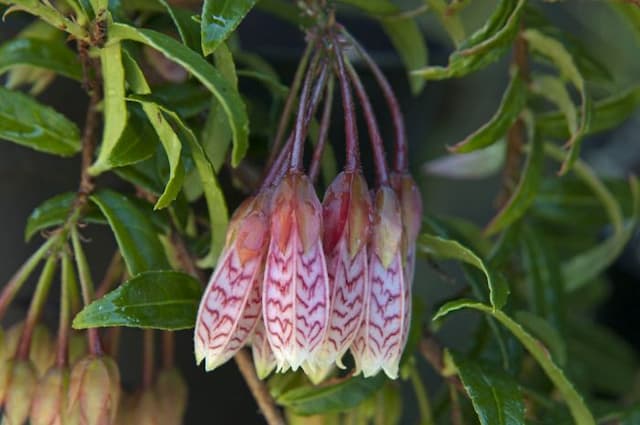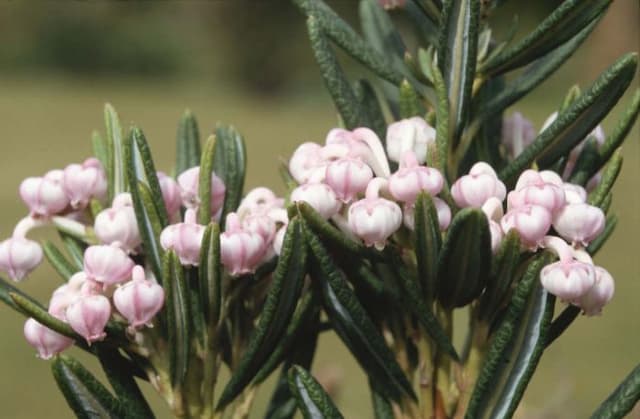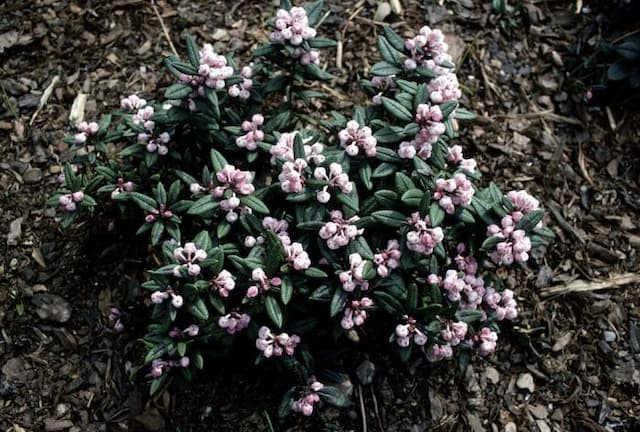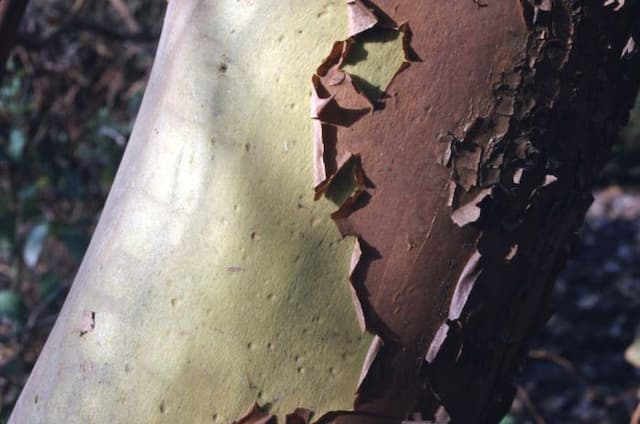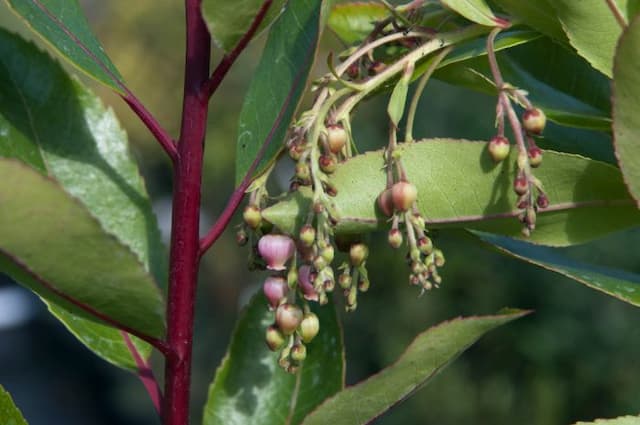Rhododendron 'Monsieur Marcel Ménard' Rhododendron 'Monsieur Marcel Ménard'

ABOUT
An evergreen, medium-sized shrub with small, recurved green leaves and rounded trusses of open, funnel-shaped, deep violet flowers with yellow-green to brownish markings, in late May to early June.
About this plant
 Names
NamesSynonyms
Rhododendron, Azalea.
Common names
Rhododendron 'Monsieur Marcel Menard'
 Characteristics
CharacteristicsLife cycle
Perennials
Foliage type
Evergreen
Color of leaves
Green
Flower color
Purple
Height
4-6 feet (1.2-1.8 meters)
Spread
4-6 feet (1.2-1.8 meters)
Plant type
Shrub
Hardiness zones
5-8
Native area
Asia
Benefits
 General Benefits
General Benefits- Ornamental appeal: Rhododendron 'Monsieur Marcel Ménard' has attractive flowers and foliage, making it a popular choice for adding aesthetic value to gardens and landscapes.
- Habitat support: The plant provides shelter and food for wildlife, such as butterflies, bees, and birds that are attracted to its blooms.
- Erosion control: With its dense growth habit, it can help stabilize soil and prevent erosion on slopes or in areas where this might be a concern.
- Low maintenance: Once established, rhododendrons require relatively little care, which makes them a convenient option for gardeners of all skill levels.
- Shade tolerance: This rhododendron can thrive in partially shaded areas where other plants might not grow as well, providing gardening options for areas with limited sunlight.
- Seasonal interest: With its vibrant and colorful spring blooms, it contributes to the seasonal dynamics of a garden, creating visual interest throughout the year.
 Medical Properties
Medical PropertiesThis plant is not used for medical purposes.
 Air-purifying Qualities
Air-purifying QualitiesThis plant is not specifically known for air purifying qualities.
 Other Uses
Other Uses- Photography Subject: Rhododendron flowers, especially the 'Monsieur Marcel Ménard' variety, are often used as a subject in photography due to their large, showy blooms that offer vibrant colors and textures.
- Wedding Decor: The large, attractive flowers of rhododendrons can be used in wedding bouquets and arrangements, adding elegance and color to the special day.
- Dye Production: The pigments from rhododendron petals can be extracted to produce natural dyes for textiles or artisanal crafts.
- Culinary Garnish: While not all rhododendron parts are edible, certain varieties with known edibility can have their blossoms used as a colorful garnish for food presentation.
- Artistic Inspiration: The unique form and color of rhododendron flowers, like those of 'Monsieur Marcel Ménard,' often serve as inspiration for artists, leading to paintings, sketches, and sculptures.
- Educational Tool: In botanical gardens and educational programs, rhododendrons are used to teach botany, plant taxonomy, and the importance of plant diversity.
- Scented Products: The fragrance of some rhododendron varieties may be used as inspiration for perfumes and scented candles, though care must be taken to ensure safety due to toxicity of certain species.
- Cultural Symbolism: In certain cultures, rhododendrons hold symbolic meaning and may be used in rituals or as a national symbol, as is the case in Nepal where rhododendrons are the national flower.
- Habitat Creation: Rhododendrons can be planted to create habitats for pollinators such as bees, butterflies, and hummingbirds, providing necessary resources and supporting biodiversity.
- Frost Protection: When planted strategically in gardens, the rhododendron's evergreen foliage can provide some measure of frost protection for nearby less hardy plants by creating a microclimate.
Interesting Facts
 Feng Shui
Feng ShuiThe Rhododendron is not used in Feng Shui practice.
 Zodiac Sign Compitability
Zodiac Sign CompitabilityThe Rhododendron is not used in astrology practice.
 Plant Symbolism
Plant Symbolism- Warning: Rhododendrons, including 'Monsieur Marcel Ménard', are often associated with caution due to their toxic properties. In the language of flowers, they can symbolize a warning to beware.
- Elegance and Wealth: Because of their lush, full blooms and the fact that they were historically collected by the elite, rhododendrons can represent elegance and wealth.
- Passion: The intense vibrant colors of Rhododendrons' blooms have been connected with passion and liveliness.
- Homecoming and Hospitality: In some cultures, the Rhododendron is a herald of homecoming and hospitality, as the plant is often grown in gardens and welcomes visitors with its beauty.
- Survival: These plants are known for their hardiness and ability to thrive in various climates, which is why they can symbolize the ability to overcome challenges or withstand adversity.
 Water
WaterRhododendrons, including 'Monsieur Marcel Ménard', should be watered thoroughly whenever the soil begins to dry out, usually once a week. Use enough water to soak the root zone deeply which means about one inch of water per week. Avoid overhead watering to minimize the risk of fungal diseases; instead, water at the base of the plant. During hot spells or dry seasons, you may need to water more frequently, possibly twice a week. Reduce watering in the winter when the plant's water needs decrease.
 Light
LightRhododendrons thrive in dappled sunlight or part shade. The 'Monsieur Marcel Ménard' variety should be planted in a location where it will be protected from harsh afternoon sun. Morning light is preferable, with some shade during the hottest part of the day to prevent scorching of the leaves.
 Temperature
TemperatureRhododendrons, including 'Monsieur Marcel Ménard', prefer moderate temperatures and can generally tolerate a range from about 20°F to 80°F. They thrive best in temperatures between 60°F and 70°F. Extreme heat can stress the plant, and temperatures below 20°F may damage or kill the plant, so it is best to provide some protection during severe winter conditions.
 Pruning
PruningPruning a Rhododendron 'Monsieur Marcel Ménard' is done mainly to shape the plant or remove dead and diseased wood. The best time to prune is soon after the flowers have faded in spring. Do not prune too late in the season as this can remove next year's buds. Prune sparingly to maintain a natural shape, removing only what is necessary.
 Cleaning
CleaningAs needed
 Soil
SoilRhododendrons require acidic soil with a pH range of 4.5 to 6.0. The best soil mix is one that is well-draining and rich in organic matter. A mix of 50% peat moss or coco coir with 40% pine bark and 10% perlite or coarse sand is ideal for Rhododendron 'Monsieur Marcel Ménard'.
 Repotting
RepottingRhododendron plants, commonly known as Azaleas, typically require repotting every 2-3 years as they are slow to moderately growing plants. Rhododendron 'Monsieur Marcel Ménard' should be repotted when it outgrows its current container or when the soil becomes depleted or compacted.
 Humidity & Misting
Humidity & MistingAzaleas like Rhododendron 'Monsieur Marcel Ménard' thrive in environments with moderate to high humidity levels, ideally between 50-60%. Avoid placing them in overly dry conditions and use a humidifier if necessary to maintain the best humidity level.
 Suitable locations
Suitable locationsIndoor
Keep in bright, indirect light and maintain high humidity.
Outdoor
Plant in dappled shade, protect from strong winds, acid soil.
Hardiness zone
5-8 USDA
 Life cycle
Life cycleThe life of the Rhododendron 'Monsieur Marcel Ménard', commonly known as Rhododendron, begins with seed germination, where warmth and moisture trigger the development of a root system and sprout. After germination, the seedling enters a juvenile growth phase, during which it establishes a root system and begins to produce leaves. As the plant matures, it enters a vegetative state characterized by further foliage growth and the development of sturdy stems. When the Rhododendron reaches maturity, it enters the flowering phase, producing vibrant flowers that attract pollinators, crucial for sexual reproduction and genetic diversity. Following pollination, the flowers develop into seed capsules, which eventually dry and release seeds to start a new life cycle. Lastly, the plant may experience a period of dormancy, especially in colder climates, where growth slows or pauses before resuming in the next growing season.
 Propogation
PropogationPropogation time
Spring-Early Summer
The Rhododendron 'Monsieur Marcel Ménard', commonly referred to simply as Rhododendron, is typically propagated through semi-hardwood cuttings. This method is preferred because it preserves the characteristics of the parent plant. The best time for taking cuttings is late summer after the plant has ceased blooming and the new growth has begun to harden. To do this, select healthy shoots from the current year's growth and cut a section about 4 to 6 inches (about 10 to 15 centimeters) long, making sure there are at least two sets of leaves. The bottom cut should be made just below a set of leaves. After removing the lower leaves, dip the cut end into a rooting hormone to encourage root development. The cutting should then be placed in a mixture of 50% peat and 50% perlite or coarse sand, ensuring adequate moisture and warmth to facilitate rooting, typically within several weeks to a few months.
